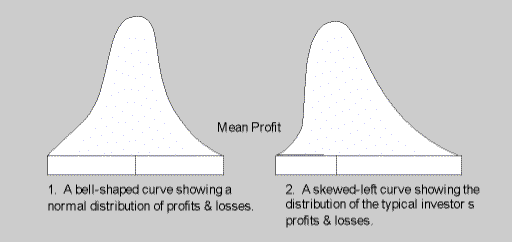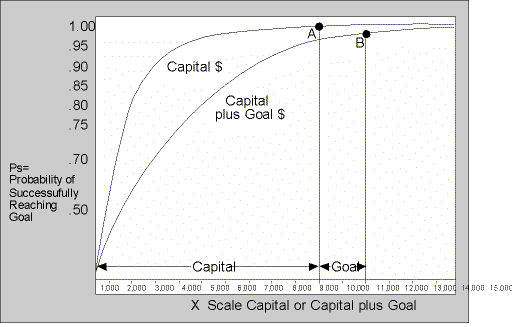
| Monthly
Article
Topics for November |
||
|
This
Issue
Various
Topics
Tech
Talk
Market Statistics
Notice:
Copyright (c) 1999 Commodity Systems Inc. (CSI). All rights are reserved.
|
Topics discussed in this month's journal.
Holiday Schedule CSI will be closed for voice communication on Thursday, November 25 for the Thanksgiving holiday. U.S. exchanges will be closed, but data from those exchanges that remain open will be available according to the current Data Release Schedule. The CSI host computer will be accessible as usual throughout the holiday weekend.
The modern investor is bombarded with offers of trading systems, managed accounts and newsletters. In addition, through the application of various user-defined analysis programs, traders are conceiving more personalized systems every day. They typically explore and predict trading opportunities through hindsight historical testing. What all of these ventures have in common is a performance record. These records are usually characterized by claims of substantial profit. All claims, whether supported by simulated hindsight profits or actual trading performance, can be statistically analyzed and rated with the Trading System Performance Evaluator (TSPE). This program was originally released almost a decade ago, but a new version of TSPE will become available soon in an upcoming Unfair Advantage® release. With TSPE, every system or approach can be evaluated against a standard set of rules. In some cases, when the promoter is willing to share his performance record, that record can be evaluated before the product or service is purchased. TSPE's Objective TSPE's objective is to find the probability that a proposed dollar goal can reasonably be achieved with a given capital stake, and to compute the expected level of goal satisfaction. Your required capital stake, measured in dollars, is a key sobering output that every trader needs to know to finance the anticipated trading exercise. No one should attempt to trade a particular systematic approach without knowing in advance what capital outlay must be advanced to achieve a known probability of success.
In offering TSPE within UA, we will be providing a tool for uncovering
the more promising trading systems or track records, and for detecting
improperly conceived methods. This is a service that will guide your trading
efforts and inform you whether or not there is an ample chance of succeeding
in the market arena with your newly found or purchased product.
Each session continues until: 1. Residual
capital is insufficient to meet the exchange-imposed dollar margin requirement;
or
TSPE repeats each session for a range of capital levels, keeping records on the percentage of winning sessions. The winning percentage for each capital level is presented as the probability of reaching the goal.
The statistical terms for the techniques used are "sampling with replacement"
and "Monte Carlo Simulation." These are two of the few methods capable
of solving this type of problem.
In military applications, Monte Carlo simulation is used to find problems
in the design/development stage. It helps contractors avoid costly revisions
and corrections in post-design reality. When applied to trading systems
or promoter track records, it can uncover otherwise unforeseen problems,
assumptions or weaknesses before capital is risked in actual trading.
Correction is always more severe for hindsight analysis because through user-control parameters, profits are inflated based on known market behavior in the past. The magnitude of the correction is directly proportional to the parameter count and inversely proportional to sample size. Results improve with larger samples and the absence of excessive user control.
A by-product of the simulation exercise is a statistic that discloses the
drawdown potential implicit from the user's input P&L string. This
statistic produces the 95% confidence level of drawdown derived from repetitive
trading sessions in the simulation exercise.
TSPE can accommodate an unlimited number of P&L input sets, but each
set is analyzed independently of the others. A set can represent a given
commodity, security, or a group of like markets that have been handled
the same way. These sets can have the same or varying levels of market
exposure.
This is because the typical prudent investor cuts losses and lets profits
run. As investors, we literally bank on having occasional large profits
and many small losses. In order to have a normally distributed P&L
curve, the investor would have to log as many big losses as big profits.
Fortunately, this is not normally the case, so the typical trader's distributional
curve is skewed heavily to the left, where losses are more frequent. TSPE
will naturally focus upon the random likelihood of consecutive losses in
assessing the capital necessary to achieve a profitable outcome that will
reach a user's predetermined goal. This skew factor typically inflates
the sample size requirement.
In sampling theory, many more trials are required to establish the relative frequency of a rare event than are required to verify a likely event. In a skewed distribution where the mean, median and mode are all pushed left (see chart 2 above), it is mandatory to introduce enough trials so rare profits have a good chance of appearing. This situation produces the need for a larger sample size that includes the rare large-profit events. It also heavily impacts upon the capital necessary to sustain trading when many losing trades must be financed before rare large profits develop.
For these reasons, the sample size requirement is inflated. Patience becomes
not only a virtue, but a necessity to bank profits using the typical market
trading system.
[This example of a TSPE output screen shows that $10,000 is the required capital for a 99% chance (point A) of goal achievement with a particular trading system. Point B identifies the user-defined goal ($2,000 profit) plus capital at a probability level of 97%.] Using the above chart, simply zoom in on the success probability level at which you plan to operate, and interpolate to the capital plus goal requirement you must assume. If you can afford to risk that capital level to achieve your specified goal with the odds you have selected, you should consider proceeding with your systematic trading exercise. On the 'X' scale of the above chart, point A might represent your capital outlay and point B might represent your capital outlay plus your goal. (Your goal would be the difference between B and A.) To trade your system, you will be risking A to achieve a profit of B-A, for example. We wish you the best in your trading, and we sincerely hope that, should the odds you must assume and the risk you must afford be too great for your situation, you will re-think your system's approach before commencing trading.
Since Sheldon Knight's "How Clean Is Your Data?" article appeared in the September 1999 edition of Futures magazine, we have received many calls from people wanting to know how to use CSI data with their trading software. RadarScreen, which is Omega Research's 2000I product, was a program of special concern. Data format compatibility was not really the problem; it was more a matter of convenience (or lack thereof). While Omega requires only 10 or 12 mouse clicks to use RadarScreen with all of the stocks in their own historybank.com database, any outside database requires about 40 keystrokes per stock, plus a requirement to enter the stock symbol twice and the full stock name once. The 2.7 million required mouse clicks take the bulk of the time to identify all of CSI's stocks with Omega's 2000I product. Whether or not it was the intent, the result of these extra mouse clicks is to effectively discourage use of any third-party database. Since so many Omega customers wanted to use CSI data with their RadarScreen, we added a file to UA containing all the stock information, and included programming (CSI's StockScannerTM) to automatically supply the many mouse clicks required of RadarScreen to use a vendor other than Omega's private label of historybank.com. These enhancements reduce the cumbersome procedure to a totally automated 14-step process. We've included a document file called RadarScreenInstructions.doc in UA version 2.0.1 that gives instructions for using CSI's Unfair Advantage database. The steps are fairly easy to apply, but the process takes considerable disk space, and one very long step must be endured to get the job done in perhaps one full weekend. If you missed Mr. Knight's article, you may be wondering why anyone would go to such lengths simply to use a different data supplier. The article reported that Omega committed some 21.75 errors and omissions per year per data symbol; whereas CSI, the best overall vendor, committed 4.48 per year per data symbol (based on a controlled study using S&P 500 futures and CBOT commodity). If equivalent performance can be extrapolated to stocks, then the result of any trading experience might be dramatically improved by using CSI for your analytical work. Omega's projected error rate of 21.75 errors per year (250 trading days) translates into .087 errors per day. If RadarScreen scans a 30-day period for any given stock, the chance that all 30 days of data is error free is less than 6.6%. Investing real dollars on such slim prospects of accuracy would, it seems, certainly violate anyone's level of tolerance. A summary conclusion of the Sheldon Knight study compared the performance of Omega's data bank with CSI using a simple breakout system and found that Omega's profit performance, over a two-year period, varied by as much as 50% below that of CSI. Data source does make a HUGE difference in results, not to mention the enormous waste of time in analyzing thousands of stocks without gaining a sound conclusion and dependable course of action. To their credit, Omega allowed us to run an advertisement in their Omega magazine demonstrating the superiority of CSI data over their own. Omega makes a great product, but restricting vendor choice through millions of required mouse clicks and unnecessary procedure is not a way to foster great customer satisfaction. In a full page letter in S&C Magazine's Nov. '99 edition (p. 27), Bill Cruz of Omega Research said in the introductory topic sentence of his letter, "Your financial success is important to us." If he really means that, perhaps he will listen when you ask that he make his products work as well with outside databases as with his private label database.
The CBT and MidAmerica exchanges are in the process of changing contract specifications for some of their most popular contracts, the Benchmark 30-Year U.S. Treasury Bond and the two-, five- and ten-year Treasury Notes. The December 1999 contracts are for 8% bonds and notes and the subsequent contracts (March 2000) are for 6% bonds and notes. The change, of course, reflects changes in the U.S. Treasury markets themselves. Discontinuities in contract specifications such as this can be problematic for investors doing long-term technical analysis, and a popular solution is to adjust the data from the older contracts to reflect the new specifications. We plan just such an adjustment through Unfair Advantage. Upon expiration of the 12/99 contract (around Dec. 21), all UA users will automatically receive adjustments that will apply a ratio to all previous T. Bond and T. Note data, bringing them to a level comparable to the new 6% prices. The adjustments can be turned on and off using the "View", "User Settings", "Data Handling," "Adjust data series for unit of measure changes" option. An October 1999 Futures magazine article argued against using ratios to adjust T. Bond data, but failed to mention that this prohibition more appropriately referred to the cash market only. We consulted the CBT on using a ratio, and they concurred that it is appropriate. Users of Perpetual Contract Data have probably noticed the impact of the disparate yields in the Bond and Note markets. This problem will intensify until the December contracts are dropped from your Perpetual Contract series. It is possible to apply the adjustment before December 21 to get better results from Perpetual Contract Data. Applying these adjustments early will distort data on the current December contracts, however. Keep in mind that you can turn them off according to your immediate needs. To manually adjust, add the following lines to UA's cdbadjust.adm file: 44,P,,,,199912,Y,0.80039624
QuickTrieve® users will not receive the adjustment file, but will have
the opportunity to purchase adjusted historical data after the December
Note and Bond contracts expire. Please feel free to contact our Technical
Support Staff if you need assistance. They can be reached at (561) 392-8663
or via e-mail at techsupport@csidata.com.
PAGE 1
|
|
|




